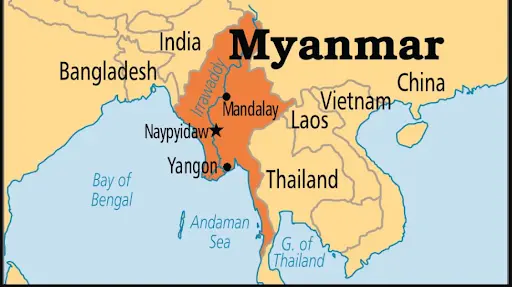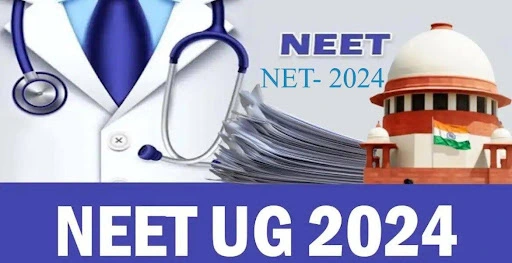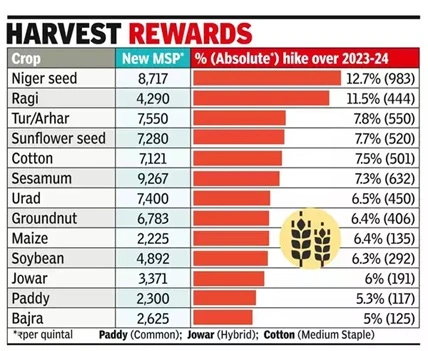Wednesday, 26th June 2024
PESA has boosted forest conservation in India
Why in the news ?
- The Panchayat (Extension to Scheduled Areas) Act empowered the Scheduled Tribes as political actors; and as they needed to protect trees for their livelihoods, it made them hostile to commercial timber and mining.
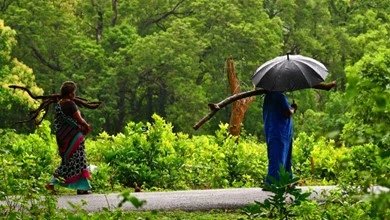 What is the PESA Act ?
What is the PESA Act ?
About:
- The Panchayat (Extension to Scheduled Areas) Act (PESA), enacted in 1996, mandates that local government councils in Scheduled Areas reserve all chairperson positions and at least half of the seats for Scheduled Tribes (ST).
- This legislative framework aims to empower marginalised communities by enabling their direct participation in local governance and resource management.
Implementation of PESA:
- India differs significantly from the 73rd Amendment, which applies to non-Scheduled Areas, by ensuring mandated representation for Scheduled Tribes (STs) in decision-making bodies.
- The variations in PESA implementation across states underscore both the challenges and successes in translating legislative intent into effective governance structures.
How PESA Ensures Equitable Representation:
- Impact on Forest Conservation:
- The study utilises a "difference-in-differences" methodology to assess PESA's effect on forest cover.
- It finds that areas with mandated Scheduled Tribe (ST) representation under PESA exhibit lower rates of deforestation and higher afforestation rates compared to areas without such representation.
- Economic Incentives for Conservation:
- ST communities, heavily reliant on forest resources for their livelihoods, are motivated to conserve forest cover under PESA.
- This approach fosters a "forest stewardship" mechanism where STs engage in sustainable practices and resist pressures from deforestation linked to mining and commercial activities.
On Democratic Decentralisation:
- Comparison with Administrative Decentralisation:
- The paper distinguishes between administrative decentralisation, which prioritises efficiency, and democratic decentralisation exemplified by PESA.
- The latter underscores representative and accountable local governance structures with decision-making autonomy over resource management.
- Single Umbrella Institution:
- Advocates suggest consolidating power into a single, empowered institution capable of integrating conservation and development goals effectively.
- Such an institution could adeptly navigate the complexities of balancing local economic interests with sustainable conservation practices.
Conclusion:
PESA stands as a pivotal illustration of how legislative mandates for political representation can simultaneously foster positive environmental outcomes and alleviate socio-economic disparities among forest-dwelling communities in India.
|
UPSC Civil Services Examination, Previous Year Question (PYQ) Prelims Q1. At the national level, which ministry is the nodal agency to ensure effective implementation of the Scheduled Tribes and Other Traditional Forest Dwellers (Recognition of Forest Rights) Act, 2006? (2021) (a) Ministry of Environment, Forest and Climate Change (b) Ministry of Panchayati Raj (c) Ministry of Rural Development (d) Ministry of Tribal Affairs Ans: (d)
Q2. A particular State in India has the following characteristics: (2012)
Which one among the following States has all the above characteristics? (a) Arunachal Pradesh (b) Assam (c) Himachal Pradesh (d) Uttarakhand Ans: (a)
Mains Q:1 “The most significant achievement of modern law in India is the constitutionalization of environmental problems by the Supreme Court.” Discuss this statement with the help of relevant case laws. (2022) Q:2 What are the two major legal initiatives by the state since Independence, addressing discrimination against Scheduled Tribes (ST)? (2017) |
Source: TH
Government Offers Ten New Critical Mineral Blocks
Why in the news ?
- Recently, the Ministry of Mines' launch of the fourth tranche of critical minerals auction, offering 21 blocks across 14 states.
 What are the Critical minerals ?
What are the Critical minerals ?
- Critical minerals are raw materials crucial for economic and national security, primarily utilised in advanced industries and renewable energy technologies.
- These minerals are characterised by their rarity, challenging extraction processes, and limited substitutes, making them susceptible to supply chain disruptions influenced by global production constraints and geopolitical dynamics.
- The increasing global demand for critical minerals, driven by technological advancements and the shift towards sustainable energy solutions, highlights their pivotal role.
- Securing a stable supply of these minerals is essential for ensuring economic resilience and facilitating technological innovation worldwide.
Characteristics of Critical Minerals:
- Economic Importance:
- Critical minerals are essential for manufacturing high-tech devices, electric vehicles (EVs), energy storage systems, and other key industries critical to economic growth and technological advancement.
- Supply Chain Vulnerability:
- The supply of critical minerals is concentrated in a few countries or regions, making them vulnerable to geopolitical tensions, trade disputes, and other global disruptions.
- This concentration increases the risk of supply shortages and price volatility.
- Limited Substitutability:
- These minerals often have few or no viable substitutes due to their unique chemical and physical properties.
- As a result, disruptions in their supply chain can lead to significant economic and technological impacts, affecting industries that rely heavily on these materials.
Examples of Critical Minerals:
- Lithium:
- Used in lithium-ion batteries for electric vehicles (EVs), consumer electronics, and energy storage systems.
- Australia and Chile hold the largest reserves of lithium available in mines worldwide, according to the US Geological Survey (USGS).
- Cobalt:
- Essential for battery production, aerospace components, and high-strength alloys.
- The Democratic Republic of Congo (DRC) is the largest global supplier of cobalt, possessing nearly half of all global cobalt reserves.
- Graphite:
- Critical for batteries, fuel cells, and applications requiring high temperatures.
- China held the world's largest reserves of natural graphite in 2023, totaling approximately 78 million metric tons.
- Nickel:
- Important for stainless steel production and battery manufacturing.
- Australia and Indonesia have the largest reserves of nickel in global mines today.
- Rare Earth Elements (REEs):
- Vital for electronics manufacturing, magnets, and military applications.
- China holds the majority of global rare earth reserves, estimated at about 44 million metric tons.
- Other significant reserve-holding countries include Vietnam, Russia, and Brazil.
Critical Minerals Reserves in the World & India:
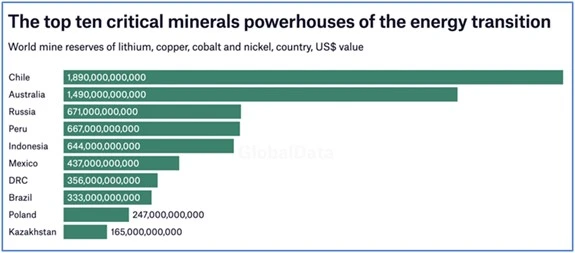
- India lacks reserves of nickel, cobalt, molybdenum, rare earth elements including neodymium and indium. Additionally, the country's demand for copper and silver exceeds its current reserves.
India’s Critical Minerals Policy:
- The Ministry of Mines, along with Khanij Bidesh India Ltd. (KABIL), is acquiring mineral assets in Australia, Argentina, and Chile to ensure a steady supply.
- India has joined the U.S.-led Mineral Security Partnership to boost cooperation and investment in critical mineral supply chains.
- The MMDR Amendment Act, 2023, empowers the Central Government to auction mining leases and licences for 24 critical minerals, promoting self-sufficiency and advancing high-tech electronics, telecommunications, and renewable energy sectors.
- The first e-auction for 20 blocks of critical minerals, including lithium and rare earth elements, launched on November 29, 2023, aims to reduce import dependency, attract investments, and support India’s self-reliance goals (Atma Nirbhar Bharat).
- A new Exploration Licence for 29 critical and deep-seated minerals encourages the use of advanced technologies in mineral discovery and mining, enhancing domestic production, securing supply chains, and contributing to India's economic growth and technological advancement.
Government Offers Ten New Critical Mineral Blocks:
- The Ministry of Mines launched the fourth tranche of critical minerals auction, offering 21 blocks across 14 states.
- To incentivize exploration, the ministry announced a scheme to reimburse up to Rs 20 crore in exploration expenses for licence holders.
- The fourth tranche brings the total number of critical mineral blocks offered to 48.
- Auction history shows mixed results: out of 48 blocks, 24 have been annulled due to low bidder interest.
- The ministry remains optimistic about successful re-auctions, with efforts to intensify investor engagement.
- The newly announced exploration reimbursement scheme aims to boost investor interest.
- Licence holders can claim up to Rs 20 crore for exploration activities and may receive additional reimbursements if they hand over a block for mining lease within three years.
- This incentive addresses concerns about the need to re-auction blocks for mining after exploration.
|
UPSC Civil Services Examination Previous Year Question (PYQ) Mains Q:1 Despite India being one of the countries of Gondwanaland, its mining industry contributes much less to its Gross Domestic Product (GDP) in percentage. Discuss. (2021) Q:2 “In spite of adverse environmental impact, coal mining is still inevitable for development”. Discuss. (2017) |
Source: IE
ISRO’s Reusable Launch Vehicle ‘Pushpak’
Why in the News?
- Recently, ISRO completed the third Reusable Launch Vehicle (RLV) Landing Experiment (LEX) of its winged vehicle ‘Pushpak’ at the Aeronautical Test Range (ATR) in Chitradurga, Karnataka.
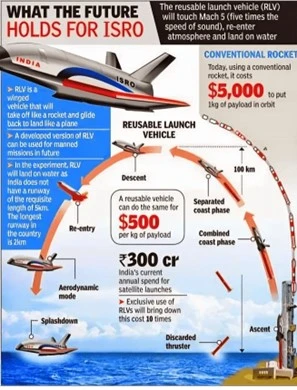 What is an RLV and How is it Different from Other Launch Vehicles?
What is an RLV and How is it Different from Other Launch Vehicles?
Primarily, launch vehicles comprise three or four stages apart from the payload, which needs to be launched into a polar or geosynchronous orbit, depending on a mission’s requirements.
- In ISRO’s 3-stage rockets:
- The first/lowermost stage has solid fuel/up to 4 liquid strap-on boosters in the GSLV;
- The second stage has the Vikas engine powered by liquid fuel; and
- The third and uppermost stage has a cryogenic engine, which uses liquid oxygen and liquid hydrogen.
- In the 4-stage PSLV:
- The first stage has a motor using solid fuel augmentable with up to six solid-fuel strap-on boosters;
- The second stage has a Vikas engine;
- The third stage again has a solid-fuel motor; and
- The fourth stage has two liquid engines.
Note:
- The RLV that ISRO is building has only two stages to propel the vehicle into orbit. Once the fuel in the first stage has been expended, the vehicle will shed it and carry on with the second stage.
- The first stage will re-enter the atmosphere and land in an autonomous fashion at a predetermined location. After some maintenance, it will be available for reuse.
What is the Significance of RLVs?
- Low lift-to-drag (L/D) ratio: In aerodynamics, the L/D ratio is the lift generated by an aircraft, divided by the aerodynamic drag caused by moving through air.
- Cost-effective: The use of two-staged RLVs can reduce the cost of a launch by nearly 80% of the current cost.
- Foundation for advanced technologies: It has the potential to serve as the foundation for advanced technologies such as:
- Hypersonic flight,
- Autonomous landing,
- Return flight experimentation,
- Powered cruise flight, and
- Air-breathing propulsion systems.
- Scientific, strategic and commercial advantages for India: The building of RLVs will ensure that the country does not lag in important scientific and strategic areas and will also commercially help ISRO.
What is the History of ISRO’s RLV Missions?
- In 2010, ISRO began developing a winged reusable rocket, taking the first step towards realising a two-stage-to-orbit (TSTO) launch vehicle that could be fully reusable.
- In 2016, the winged vehicle successfully flew at hypersonic speed and touched down at a predetermined site 425 km east of Sriharikota, in the Bay of Bengal.
- While several other related technologies have been tested through the years, ISRO’s RLV’s autonomous landing was only tested successfully in 2023.
- Currently, ISRO is working on the ‘Orbital Reentry Experiment’ (ORE), which will be taken to orbit by a modified launch vehicle comprising existing GSLV and PSLV stages. The vehicle will stay in orbit for a stipulated period, re-enter, and finally land autonomously on a runway, with landing gear.
What are the RLV LEX Missions?
- The mission was accomplished by Vikram Sarabhai Space Centre (VSSC) along with the Liquid Propulsion System Centre (LPSC) and the ISRO Inertial Systems Unit (IISU).
- This is the third and final test in the series of LEX (03), following the success of the RLV LEX-01 and LEX-02 missions.
- The third and final test re-demonstrated the autonomous landing capability of the RLV under more challenging release conditions.
- The mission simulated high-speed landing conditions for a vehicle returning from space, reaffirming ISRO’s expertise in acquiring the most critical technologies required for the development of an RLV.
|
UPSC Civil Services Examination, Previous Year Question (PYQ) Prelims Q:1 With reference to India’s satellite launch vehicles, consider the following statements: (2018)
Which of the statements given above is/are correct? (a) 1 only (b) 2 and 3 (c) 1 and 2 (d) 3 only Ans: (a) |
Source: TH
J&K’s Enemy Agents Ordinance
Why in the News?
- Recently, the J&K Director General of Police (DGP) has stated that investigating agencies should prosecute anyone found aiding militants in J&K under the Enemy Agents Ordinance 2005.
What is the Background of the J&K Enemy Agents Ordinance?
- Initially issued in 1917 by the Dogra Maharaja of J&K, it is called an ‘ordinance’ because laws made during the Dogra rule were referred to as ordinances.
- After Partition in 1947, the ordinance was incorporated as a law in the erstwhile state and was later amended.
- The Enemy Agents Ordinance 2005 (1948) was promulgated under Section 5 of the Jammu and Kashmir Constitution Act 1996.
- In 2019, with the repeal of Article 370, J&K’s legal framework underwent significant changes.
- The J&K Reorganisation Act listed state laws to continue, while others were repealed and replaced with Indian laws.
- For instance, while security laws such as the Enemy Agents Ordinance and the Public Safety Act remained, the Ranbir Penal Code was replaced with the Indian Penal Code.
What are the Salient Provisions of the J&K Enemy Agents Ordinance?
- Definition of an “enemy” agent: Anyone who conspires with another person to carry out an act intended to aid the enemy.
- Punishment: Enemy agents can be punished with death, rigorous imprisonment for life, or rigorous imprisonment for a term which may extend to 10 years, and may also be liable to a fine.
- Trials under the ordinance:
- Conducted by a special judge appointed by the government in consultation with the High Court.
- The accused cannot engage a lawyer to defend themselves unless permitted by the court.
- Appeal against the verdict:
- There is no provision for appeal against the verdict.
- The decision of the special judge can only be reviewed by a person chosen by the government from the judges of the High Court, whose decision shall be final.
- Bar on disclosure: The ordinance bars any disclosure or publication of the case tried under it without the previous authorisation of the Government.
- Trials under the ordinance: Several Kashmiris have been tried and sentenced under the Enemy Agents Ordinance.
Conclusion
Thus, The Enemy Agents Ordinance is a stringent measure to combat militancy in Jammu and Kashmir, imposing severe penalties and restricting legal defences to deter and punish those aiding militants. However, its rigorous provisions and lack of appeal options raise significant human rights and legal concerns, emphasising the need for a balanced approach.
|
UPSC Civil Services Examination, Previous Year’s Question (PYQs) Prelims Q:1 With reference to the Delimitation Commission consider the following statements: (2012)
Which of the statements given above is/are correct? (a) 1 only (b) 2 only (c) Both 1 and 2 (d) Neither 1 nor 2 Ans: C
Q:2 Which one of the following is the largest (areawise) Lok Sabha constituency? (2008) (a) Kangra (b) Ladakh (c) Kachchh (d) Bhilwara Ans: (b)
Q:3 Siachen Glacier is situated to the (2020) (a) East of Aksai Chin (b) East of Leh (c) North of Gilgit (d) North of Nubra Valley Ans: (d)
Mains Q:1 To what extent is Article 370 of the Indian Constitution, bearing marginal note “Temporary provision with respect to the State of Jammu and Kashmir”, temporary? Discuss the future prospects of this provision in the context of Indian polity. (2016) Q:2 The banning of ‘Jamaat-e-Islami’ in Jammu and Kashmir brought into focus the role of over-ground workers (OGWs) in assisting terrorist organisations. Examine the role played by OGWs in assisting terrorist organisations in insurgency-affected areas. Discuss measures to neutralise the influence of OGWs. (2019) |
Source: IE
Lithium Mining in India
Why in the News?
- Recently, exploration of lithium in Chhattisgarh’s Korba district has progressed, with one block advancing to the second round of auctions and promising deposits identified in another block's initial exploration.
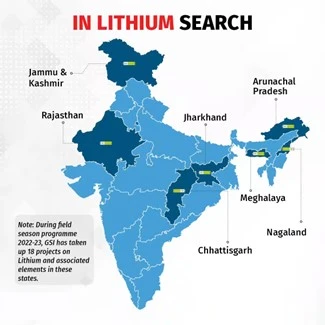 About Lithium:
About Lithium:
- Properties: Lithium is a chemical element with the symbol Li and atomic number 3. It is a soft, silvery-white alkali metal.
- Characteristics: Lithium is light and soft, can be cut with a kitchen knife, and is so low in density that it floats on water.
Applications of Lithium:
- Rechargeable Batteries: Used in mobile phones, laptops, digital cameras, and electric vehicles (EVs). Often called "white gold" for EVs.
- Alloys: Made into alloys with aluminium and magnesium to improve strength and reduce weight. Used in aircraft, bicycle frames, and high-speed trains.
- Biological Role: Lithium has no known biological role and is toxic except in very small doses.
Where is Lithium Found Naturally?
- Earth’s Crust: Makes up 0.0007% of the Earth's crust, found locked in minerals and salts.
- India: The Geological Survey of India found 9 million tonnes in Salal-Haimana area of Reasi district, J&K. India now has the third largest lithium resource globally, but conversion to reserves will take time.
- Global Production: Surpassed 100,000 tonnes in 2021, with Australia producing 52% of the world’s lithium.
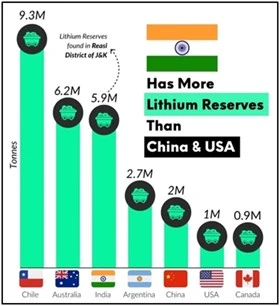 Future of Lithium Production:
Future of Lithium Production:
- Demand Projections: Expected to reach 1.5 million tonnes of lithium carbonate equivalent (LCE) by 2025 and over 3 million tonnes by 2030.
- Production Needs: Must triple by 2025 and increase nearly six-fold by 2030 to meet demand.
Lithium Mining in India:
- Chhattisgarh: Exploration in Korba has advanced, with one block moving to the second auction round and another showing promising deposits.
- Challenges: Setbacks include cancelled auction in J&K’s Reasi district due to low investor interest and halted exploration in Manipur's Kamjong district due to local resistance.
- Exploration Efforts: Efforts in Manipur, Ladakh, and Assam have been less successful due to local resistance and poor results.
- National Mineral Exploration Trust (NMET): Funded a private company that found lithium deposits in Korba ranging from 168 to 295 ppm.
- Auctions: Since November, the Mines Ministry has auctioned 38 critical mineral blocks, including lithium blocks in J&K and Chhattisgarh. Korba block attracted investors, but Reasi block did not and is being re-auctioned.
- International Assets: Despite mixed domestic results, India has secured lithium assets abroad, such as in Argentina’s Catamarca province through Khanij Bidesh India Limited (KABIL), and is exploring opportunities in Sri Lanka and Australia.
|
UPSC Civil Services Examination, Previous Year Question (PYQ) Prelims Q:1 Which one of the following pairs of metals constitutes the lightest metal and the heaviest metal, respectively? (2008) (a) Lithium and mercury (b) Lithium and osmium (c) Aluminium and osmium (d) Aluminium and mercury Ans: (b) |
Source: IE
Kerala Assembly Passes Resolution to Change State's Name
Why in the News?
- Recently, Kerala Assembly has unanimously passed a resolution urging the Centre to rename the state as “Keralam’’ in the Constitution. This is the second time in the past year that such a resolution has been passed.
 Process of Changing the Name of a State:
Process of Changing the Name of a State:
- Constitutional Provision
- Article 3 of the Indian Constitution outlines the process for changing the name of a state.
- Article 3 also empowers the Parliament to:
- Form new states by separating territory from existing states, uniting states or parts of states, or attaching a territory to a state.
- Increase or decrease the area of a state.
- Alter the boundaries of a state.
- Proposal by the State Legislature:
- The proposal to change the name of a state typically begins with a resolution passed by the state legislature.
- The resolution reflects the desire of the state to change its name.
- This process can also be initiated by the central government through a proposal to change the name of a state.
- Recommendation by the President:
- Once the state legislature passes the resolution, it is sent to the central government.
- If the proposal is initiated by the central government, it must be submitted to the President of India.
- The President of India must recommend the proposal to the Parliament before any action can be taken.
- Introduction of a Bill in Parliament:
- A bill to alter the name of a state is introduced in either house of Parliament (Lok Sabha or Rajya Sabha).
- The bill can only be introduced with the prior recommendation of the President.
- Referral to the State Legislature:
- Before the bill is taken up for consideration in Parliament, the President is required to refer it to the legislature of the state concerned for expressing its views within a specified period.
- This is done to seek the opinion of the state legislature on the proposed change.
- Consideration of State Legislature's Views:
- The state legislature’s views are communicated back to the central government.
- However, the Parliament is not bound by the state legislature’s opinion. It is merely a consultative process.
- Passage of the Bill in Parliament:
- The bill must be passed by a simple majority in both houses of Parliament (Lok Sabha and Rajya Sabha).
- This means more than half of the members present and voting must approve the bill.
- Assent of the President:
- Once both houses of Parliament pass the bill, it is sent to the President for assent.
- Upon receiving the President’s assent, the bill becomes law, and the name of the state is officially changed.
- Notification in the Official Gazette:
- The change in the state’s name is then notified in the Official Gazette of India. This marks the formal and legal change of the state’s name.
Resolution Passed by the Kerala Assembly:
About:
- Kerala Chief Minister Pinarayi Vijayan moved a resolution stating that the state's name should be changed to "Keralam" in the Constitution to match its Malayalam name.
- The Kerala Assembly unanimously requested the Union Government to make this change under Article 3.
- A similar resolution was passed on August 9 last year but needed reintroduction due to technical issues.
- The previous resolution aimed to amend the First Schedule (list of states) and inadvertently omitted a demand to amend the Eighth Schedule (list of official languages). This oversight led to the reintroduction of the modified resolution.
Why Keralam:
- Kerala is the English version of the Malayalam word "Keralam," with several theories about its etymology.
- The earliest mention is in Emperor Ashoka’s Rock Edict II from 257 BCE, referring to "Keralaputra" or "son of Kerala," associated with the Chera dynasty.
- German linguist Dr. Herman Gundert noted that "keram" in Kannada corresponds to "cheram," describing the coastal land from Gokarna to Kanyakumari.
- The term "cher" in Old Tamil means to join, possibly indicating the origin of the name.
Story of Statehood:
- The demand for a united Malayalam-speaking state began in the 1920s, aiming to integrate Travancore, Cochin, and the Malabar district.
- After independence, on July 1, 1949, Travancore and Cochin merged to form Travancore-Cochin.
- The State Reorganisation Commission recommended creating states on linguistic bases.
- This led to the inclusion of Malabar and Kasargod into the new state for Malayalam speakers and the exclusion of four southern taluks of Travancore, now part of Tamil Nadu.
- Kerala was officially formed on November 1, 1956.
Source: IE
Poori Padhai Desh Ki Bhalai
Why in the news ?
- Recently, NGO Child Rights and You (CRY) has launched a nationwide campaign, “Poori Padhai Desh Ki Bhalai,” to increase the participation of the girl child in Indian schools.
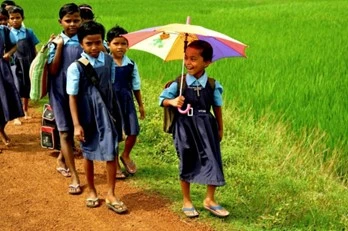 Status of Female Education in India:
Status of Female Education in India:
- 2011 Census Data: Male literacy rate stood at 82.14%, while the female literacy rate was lower at 65.46%.
- Rural Education: Only 1 out of every 100 girls in rural India reaches class 12, and 40% drop out before completing the fifth standard.
- Literacy Rates: Over the last decade, rural women have shown the highest increase in literacy rates, with a rise of 26%.
- Gross Enrolment Ratio:
- Elementary Level: Female ratio is 94.32%, slightly higher than 89.28% for boys.
- Secondary Level: Girls have a ratio of 81.32% compared to 78% for boys.
- Higher Secondary Level: Girls achieve a ratio of 59.7% versus 57.54% for boys.
- Labour Market Participation: According to the “World Employment and Social Outlook Trends for Women 2018” report, more women are educated and actively participating in the labour market than ever before.
Challenges Faced by Females in Accessing Education:
- High Dropout Rates: Despite increasing enrolment rates, dropout rates and lower attendance among girls persist.
- Infrastructure Issues: Overcrowded classrooms, teacher absenteeism, lack of sanitation facilities, including girls’ toilets, and overall poor infrastructure in government schools.
- Social Norms and Customs: Early marriages, restrictions on girls’ mobility, and societal expectations contribute to lower attendance and higher dropout rates.
- Health Issues: Frequent illnesses due to inadequate nutrition and unsanitary living conditions affect girls’ attendance and educational outcomes.
- Economic Constraints: Traditional gender roles and economic constraints lead families to prioritise boys’ education over girls', as girls are perceived to be less employable.
- Patriarchal Attitudes: Societal perceptions marginalised women in social, political, and economic spheres, limiting their opportunities.
- Safety Concerns: Concerns over violence and security issues further contribute to barriers to girls’ education.
Government Schemes for Uplifting Female Education:
- Beti Bachao Beti Padhao (BBBP) Scheme: Launched in 2015, focuses on improving the declining child sex ratio and ensuring the education and empowerment of girls.
- Sarva Shiksha Abhiyan (SSA): Aims to provide universal elementary education, including interventions to improve girls’ access to and quality of education.
- Support to Training and Employment Program for Women (STEP): Provides skills training and employment opportunities to women.
- National Scheme of Incentives to Girls for Secondary Education (NSIGSE): Provides financial incentives to encourage girls from poor backgrounds to complete secondary education.
- Udaan Scheme: A CBSE initiative to promote girls’ education by providing support for their entry into technical education programs through coaching and financial assistance.
Source: DTE
Underground Coal Gasification
Why in the news?
- Recently, The Ministry of Coal has initiated India’s first Underground Coal Gasification (UCG) project at the Kasta Coal block in Jharkhand.
- Led by Eastern Coalfields Limited, this project aims to convert coal into valuable gases like methane and hydrogen for industrial use, promoting sustainable energy and enhancing coal resource utilisation.
Coal Gasification:
- Definition: Coal gasification is a process that converts coal into syngas (synthetic gas), which primarily comprises carbon monoxide (CO), hydrogen (H₂), carbon dioxide (CO₂), methane (CH₄), and water vapour (H₂O).
- Process: This conversion is achieved by reacting coal at high temperatures (typically above 700°C) with a controlled amount of oxygen and/or steam.
- Applications: The resulting syngas can be used for power generation, the production of chemical feedstocks, and as a fuel for synthetic natural gas (SNG) production.
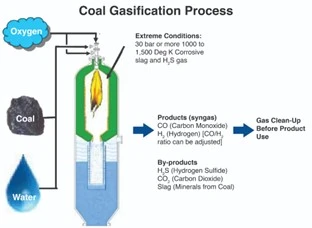 In-Situ Gasification of Coal (Underground Coal Gasification):
In-Situ Gasification of Coal (Underground Coal Gasification):
- Definition: A technique of converting coal into gas while it is still in the seam and then extracting it through wells.
- Benefits: This method offers a promising alternative for accessing deep and un-mineable coal resources with potentially lower environmental impact compared to traditional mining and surface gasification.
Advantages of Underground Coal Gasification:
- Utilisation of Un-mineable Coal: Accesses deep or thin coal seams that are not feasible to mine using conventional methods.
- Reduced Surface Disturbance: Lesser environmental and social impacts compared to traditional methods.
- Efficiency: Potentially higher efficiency and lower costs due to the elimination of coal mining, transportation, and surface gasification processes.
- Lower Emissions: The controlled environment allows for better management of emissions and pollutants.
Disadvantages of Underground Coal Gasification:
- Technical Complexity: Requires advanced technology for drilling, ignition, and maintaining controlled gasification conditions.
- Environmental Risks: Potential risks include groundwater contamination, subsidence, and uncontrolled gas migration.
- Regulatory and Public Acceptance: Addressing regulatory concerns and gaining public acceptance is crucial, especially regarding environmental and safety issues.
- Monitoring and Control: Requires continuous monitoring and control to ensure efficient operation and to mitigate potential environmental impacts.
Applications:
- Power Generation: Such as in gas turbines or combined cycle plants for electricity generation.
- Chemical Feedstocks: Production of chemicals such as methanol, ammonia, and synthetic natural gas.
- Hydrogen Production: UCG can be an alternative source of hydrogen for industrial uses and fuel cells.
Source: (PIB)
Energy Transition Index
Why in the news ?
- The World Economic Forum's (WEF) Energy Transition Index (ETI) report highlights the urgent need to address energy equity in Sub-Saharan Africa.

Energy Transition Index (ETI):
- Purpose: ETI assesses countries’ energy systems’ performance across three dimensions:
- Economic Development and Growth
- Environmental Sustainability
- Energy Access and Security
- Insights: The index provides insights into how countries balance energy transition with economic and social considerations.
- ETI 2024 Rankings:
- Top Performers:
- Sweden (1st)
- Denmark (2nd)
- Finland, Switzerland, and France follow in the top five.
- Overall Progress: Out of 120 countries, 107 have shown progress over the past decade, with 30 countries increasing their scores by more than 10%.
- Top Performers:
- Current Trends: ETI scores peaked in 2024, but the momentum of the energy transition has slowed over the past three years.
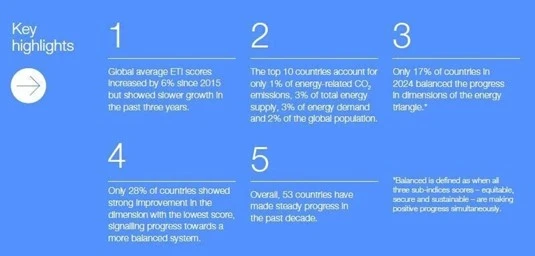
Energy Equity:
- Definition: Energy equity refers to fair access to reliable, affordable, and sustainable energy for all socio-economic groups.
- Components: Addressing disparities in energy access, ensuring affordability, and supporting sustainable energy solutions are key components of energy equity.
Challenges in Sub-Saharan Africa’s Energy Sector:
- Limited Access to Electricity:
- Approximately 600 million people lack access to electricity, impeding economic development, education, and healthcare.
- Infrastructure Costs:
- High costs associated with developing energy infrastructure in vast and sparsely populated regions.
- Fossil Fuel Dependence:
- Reliance on environmentally unsustainable fossil fuels, subject to volatile global markets, hinders the adoption of renewable energy sources.
- Financial Constraints:
- Limited financial resources and access to capital impede energy project development. Investment is deterred by perceived risks and economic instability.
- Policy and Regulatory Challenges:
- Inconsistent policies, lack of regulatory frameworks, and bureaucratic hurdles discourage private sector investment and innovation.
- Technological Barriers:
- Limited access to modern technologies and expertise slows the adoption of advanced energy solutions.
- Environmental and Social Impacts:
- Energy projects can cause displacement of communities, deforestation, and water pollution, raising environmental and social concerns.
Progress in Energy Transition:
- Sub-Saharan Africa:
- Despite challenges, the region has shown strong growth in ETI, particularly in improving energy access and affordability.
- Case Studies:
- Kenya:
- Expanded electricity access through the Last Mile Connectivity Project and investments in geothermal energy, positioning it as a leader in renewable energy.
- Rwanda:
- Made significant strides in expanding electricity access through innovative off-grid solutions and investment in renewable energy.
- Kenya:
Source: (DTE)
Transforming Indian Agriculture
Context:
- Recently, Shivraj Singh Chouhan has been appointed to lead the Ministry of Agriculture and Farmers Welfare (MoA&FW) and the Ministry of Rural Development.
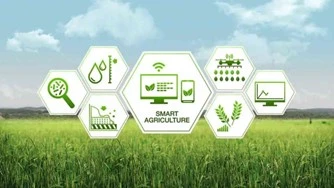
- His extensive experience as Chief Minister of Madhya Pradesh, where he achieved a 7% GDP growth and 6.8% agri-GDP growth from 2005-06 to 2023-24, makes his appointment strategic.
- The MoA&FW urgently needs to address key challenges in the agriculture sector, aiming for over 5% annual agri-GDP growth and prompt enhancement of farmers' incomes.
Significance of Agriculture in India:
- Contribution to GDP:
- The share of agriculture in the total Gross Value Added (GVA) of the economy has decreased from 35% in 1990-91 to 15% in 2022-23. This decline is due to the rapid expansion of the industrial and service sectors.
- Employment:
- According to the Periodic Labour Force Survey (PLFS) 2022-23, about 45.76% of the total workforce is engaged in agriculture and allied sectors.
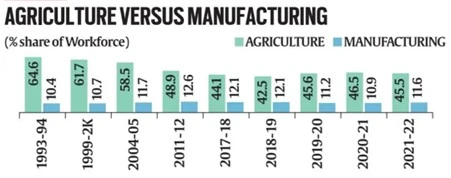
- Food Security:
- India is largely self-sufficient in staple food production, particularly rice and wheat.
- It is the world’s largest producer of milk, pulses, spices, and has the world’s largest cattle herd (buffaloes). India also has the largest area under wheat, rice, and cotton.
- India is the second largest producer of rice, wheat, cotton, sugarcane, farmed fish, sheep & goat meat, fruit, vegetables, and tea.
- Government initiatives like the Public Distribution System (PDS) and food subsidy programs rely on agricultural production to ensure affordable food access to all citizens.
- Land Use:
- Agricultural land in India constitutes a little more than 50% of the total geographical area in the country, the highest share of land use for agriculture in the world.
- India has approximately 195 million hectares under cultivation, with around 63% being rainfed and 37% irrigated.
- Foreign Exchange:
- Commodities like rice, spices, cotton, fruits, and vegetables are exported globally, generating revenue and balancing trade deficits.
- In April-January 2024, the overall value of agricultural exports stood at USD 38.65 billion. In 2022-23, the agricultural exports from India were US$ 52.50 billion.
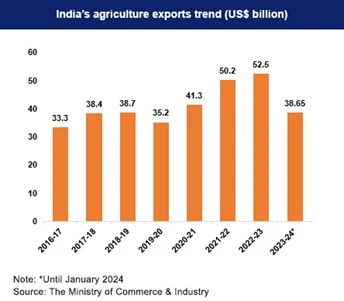
- Socio-Cultural and Environmental Sustainability:
- Agriculture is integral to India's cultural heritage and social fabric, shaping rural traditions, festivals, and community life.
- Sustainable agricultural practices are crucial for preserving soil fertility, water resources, and biodiversity, promoting long-term environmental sustainability.
Key Challenges Related to the Farm Sector in India:
- Small Land Holdings:
- The average size of operational holdings decreased from 2.28 hectares in 1970-71 to 1.08 hectares in 2015-16.
- As per India’s Agriculture Census 2015-16, 86.1% of Indian farmers are small and marginal, with landholding sizes smaller than 2 hectares.
- Economic Hardships:
- The average monthly income for a farmer's household from all sources was approximately ₹10,218, according to a 2019 NSO report.
- Small and marginal farmers frequently face challenges in accessing credit and financial services.
- Over half of agricultural households were in debt as per the 2019 NSS survey.
- Soil Degradation & Water Scarcity:
- Over-extraction of water for agriculture is depleting aquifers, making irrigation unsustainable in key regions.
- Around 90% of India's groundwater is used for agriculture.
- Improper land use, excessive chemical fertilisers and pesticides, and inadequate soil conservation lead to soil degradation.
- Inadequate Agricultural Infrastructure:
- Insufficient storage and cold chain facilities, inadequate rural roads, and limited access to markets contribute to post-harvest losses.
- Infrastructure gaps add to production costs and limit farmers’ ability to fetch fair prices for their produce.
- Outdated Farming Practices:
- Many Indian farmers still rely on traditional and outdated farming methods.
- Limited access to information and modern techniques hinders the adoption of advanced farming practices.
- Market Volatility & Price Fluctuations:
- Farmers often face price volatility due to a lack of effective market linkages, intermediaries, and price information.
- Skewed Policy Challenges:
- The government’s provision of cereals at low prices through the PDS drives down the prices farmers get for their crops.
- Skewed fertiliser subsidies promote indiscriminate usage, adversely affecting human health and environmental sustainability.
- Climate Change & Natural Disasters:
- Erratic weather patterns, climate change, and natural disasters such as floods, cyclones, and droughts pose significant challenges to India’s agriculture.
- Rainfed rice yields in India are projected to decrease by 20% by 2050 and 47% by 2080 without adaptation measures.
The Key Initiatives Related to Agriculture:
- Pradhan Mantri Kisan Samman Nidhi (PM-KISAN):
- Launch Date: February 24, 2019
- Objective: Provide financial support to farmers.
- Key Features: Direct income support of ₹6,000 per year to all landholding farmer families, paid in three equal instalments.
- Pradhan Mantri Fasal Bima Yojana (PMFBY):
- Launch Date: January 13, 2016
- Objective: Provide insurance coverage and financial support to farmers in case of crop failure.
- Key Features: Low premium rates for farmers, covers risks from pre-sowing to post-harvest, and ensures timely settlement of claims.
- Soil Health Card Scheme:
- Launch Date: February 19, 2015
- Objective: Promote soil health management practices.
- Key Features: Provides soil health cards to farmers with information on soil nutrient status and recommendations for fertilisers and amendments.
- Pradhan Mantri Krishi Sinchai Yojana (PMKSY):
- Launch Date: July 1, 2015
- Objective: Enhance water availability and use efficiency in agriculture.
- Key Features: Focuses on creating new water sources, improving existing ones, and promoting micro-irrigation techniques.
- e-National Agriculture Market (e-NAM):
- Launch Date: April 14, 2016
- Objective: Create a unified national market for agricultural commodities.
- Key Features: Integrates existing APMC markets through an online platform, facilitates better price discovery, transparency, and competition.
- National Mission on Sustainable Agriculture:
- Launch Date: 2014-15 (as part of the National Action Plan on Climate Change)
- Objective: Promote sustainable agricultural practices.
- Key Features: Focus on climate-resilient practices and technologies, efficient use of natural resources, conservation agriculture, and organic farming.
- Paramparagat Krishi Vikas Yojana (PKVY):
- Launch Date: 2015
- Objective: Promote organic farming.
- Key Features: Provides financial assistance for organic farming inputs and certification, encourages group farming and the formation of clusters.
- Digital Agriculture Mission:
- Launch Date: 2021
- Objective: Leverage technology to improve agricultural practices and productivity.
- Key Features: Focus on digital infrastructure, data management, and services for farmers, promotes the use of AI, IoT, blockchain, and drones.
- Unified Farmer Service Platform (UFSP):
- Launch Date: September 2020
- Objective: Provide integrated services to farmers.
- Key Features: Combines various agricultural services and schemes into a single digital platform, offers market information, weather updates, and advisory services.
- National e-Governance Plan in Agriculture (NeGP-A):
- Launch Date: 2010
- Objective: Implement ICT-based solutions for better governance in agriculture.
- Key Features: Develops databases and information systems for agriculture, provides online services to farmers, enhances the efficiency of government schemes and programs.
|
UPSC Civil Services Examination, Previous Year Question (PYQ) Prelims: Q:1 In the context of India’s preparation for Climate -Smart Agriculture, consider the following statements: (2021)
Which of the statements given above are correct? (a) 1 and 2 only (b) 2 and 3 only (c) 1 and 3 only (d) 1, 2 and 3 Ans: (d)
Q:2 Consider the following pairs: (2014) Programme/Project Ministry
Which of the above pairs is/are correctly matched? (a) 1 and 2 only (b) 3 only (c) 1, 2 and 3 (d) None Ans: (d)
Q:3 In India, which of the following can be considered as public investment in agriculture? (2020)
Select the correct answer using the code given below: (a) 1, 2 and 5 only (b) 1, 3, 4 and 5 only (c) 2, 3 and 6 only (d) 1, 2, 3, 4, 5 and 6 Ans: (c)
Q:1 Given the vulnerability of Indian agriculture to vagaries of nature, discuss the need for crop insurance and bring out the salient features of the Pradhan Mantri Fasal Bima Yojana (PMFBY). (2016) Q:2 Explain various types of revolutions, took place in Agriculture after Independence in India. How have these revolutions helped in poverty alleviation and food security in India? (2017) |
Source: IE
Share the article
Edukemy’s Current Affairs Quiz is published with multiple choice questions for UPSC exams
MCQ
Get Latest Updates on Offers, Event dates, and free Mentorship sessions.

Get in touch with our Expert Academic Counsellors 👋
FAQs
UPSC Daily Current Affairs focuses on learning current events on a daily basis. An aspirant needs to study regular and updated information about current events, news, and relevant topics that are important for UPSC aspirants. It covers national and international affairs, government policies, socio-economic issues, science and technology advancements, and more.
UPSC Daily Current Affairs provides aspirants with a concise and comprehensive overview of the latest happenings and developments across various fields. It helps aspirants stay updated with current affairs and provides them with valuable insights and analysis, which are essential for answering questions in the UPSC examinations. It enhances their knowledge, analytical skills, and ability to connect current affairs with the UPSC syllabus.
UPSC Daily Current Affairs covers a wide range of topics, including politics, economics, science and technology, environment, social issues, governance, international relations, and more. It offers news summaries, in-depth analyses, editorials, opinion pieces, and relevant study materials. It also provides practice questions and quizzes to help aspirants test their understanding of current affairs.
Edukemy's UPSC Daily Current Affairs can be accessed through:
- UPSC Daily Current Affairs can be accessed through Current Affairs tab at the top of the Main Page of Edukemy.
- Edukemy Mobile app: The Daily Current Affairs can also be access through Edukemy Mobile App.
- Social media: Follow Edukemy’s official social media accounts or pages that provide UPSC Daily Current Affairs updates, including Facebook, Twitter, or Telegram channels.


